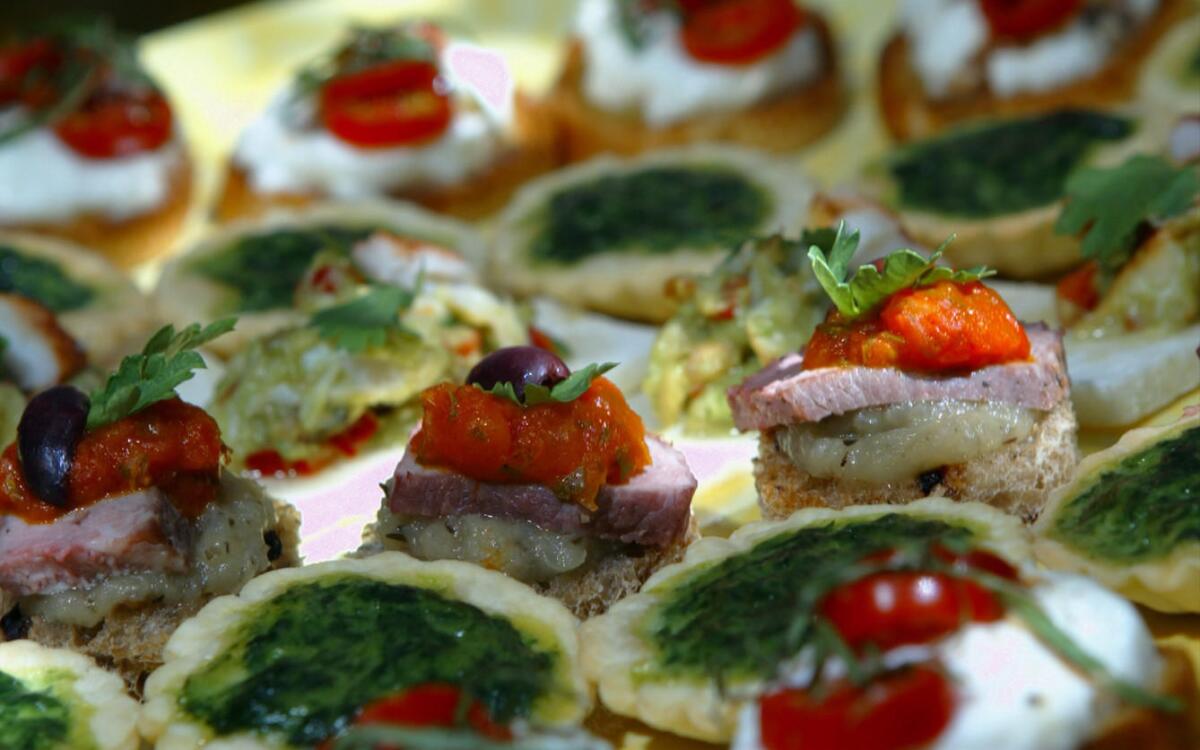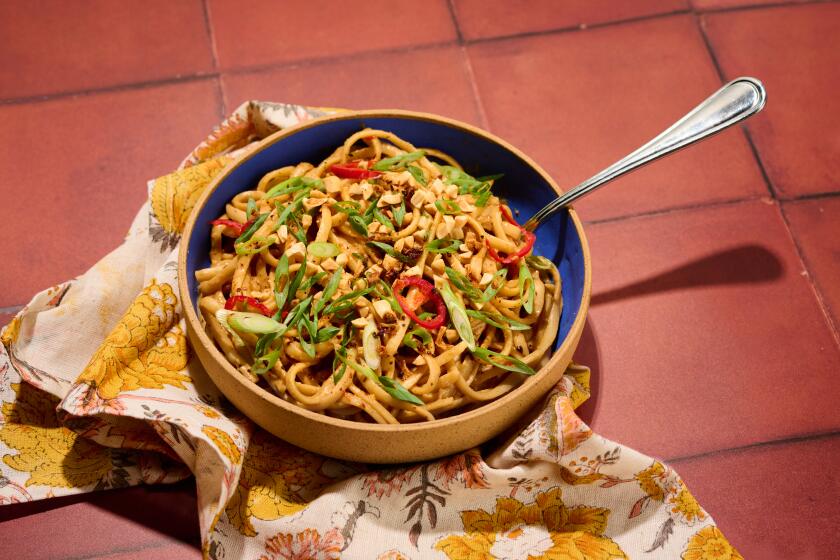Roasted lamb canapes

Everyone loves canapes.
They’re beautiful, inviting, and terribly tasty. They make a great splash either as a prelude to dinner served with glasses of sparkling wine or as an event on their own with cocktails. Canapes set a tone, alerting guests that something special’s going on, that care has been taken. They’re not just for full-blown cocktail parties -- try inviting a few friends for canapes and drinks before going out to dinner.
“A good canape should incorporate in one bite everything that’s great about a fabulous meal,” says Eric Greenstein, chef-owner of Contemporary Catering in Los Angeles.
Canapes are bite-sized hors d’oeuvres made by assembling different ingredients on bread or a bread-like base (“canape” is the French word for “couch”), though these days the definition can be stretched. The interplay of colors, textures and flavors is what makes a canape attractive and intriguing, and a tray filled with them goes the small plate craze one better. We turned to some of the top caterers around town for a selection of this season’s best.
At Along Came Mary, passed hors d’oeuvres this summer include a number of canapes made with bases other than bread, says general manager Erick Weiss. Pita cups hold mini Greek salads, won ton cups are filled with Asian slaw, and roasted potato slices form the base of tuna nicoise stacks.
Mini caprese salads seem to be on every caterer’s pick list, but the ones made by chef Elka Gilmore of Gai Klass in Culver City are distinguished by the use of burrata cheese (instead of mozzarella) topped with tiny quarters of cherry tomatoes and slivers of fresh basil. Gilmore serves hers on cracked-pepper shortbread, but we’ve opted for easy slices of toasted baguette.
“A lot of time when I’m thinking about hors d’oeuvres, I’m thinking about shrinking something,” says Gilmore, who also makes a canape with roasted lamb, sweet shallot confit and oven-dried tomato jam that was inspired by an entree she created. She serves it on toasted olive bread, but, she says, “we’ve done it on roasted zucchini. I’ve done it with roasted garlic instead of shallots. I’ve done it with reduced balsamic instead of the tomatoes.”
The layering of flavors is the essence of canape craft. Various elements -- cooked meat or seafood, confits or purees, fresh vegetables, herb garnishes -- are prepared separately, then arranged on a base. Keep canapes bite-sized, but don’t get too precious about shapes or too fussy with garnishes: This is L.A., not Stepford.
Contemporary Catering’s Greenstein has an inventive list, including lemon-poached shrimp with green-olive spread on toasts. Greenstein revived a cunning ‘50s technique for preparing the toasts: He removes the crusts from slices of white sandwich bread, then flattens the bread with a rolling pin, cuts it into squares or shapes, and bakes it until golden. Shrimp are poached in water, lemon juice and brown sugar, then dressed with olive oil, lemon juice and zest, sugar, salt and pepper. He makes his green-olive spread, but any tapenade could be used. Assembly is straightforward: a toast, a dollop of tapenade and a shrimp.
Indeed, Greenstein recommends that people who entertain a lot keep jars of tapenade, roasted red peppers, cornichons, good-quality imported tuna and anchovies and the like on hand so they can throw together canapes at the last minute.
“If you’re doing a cocktail-esque party, where you’re not serving a meal, canapes are great,” says Alexandra Angle. “They’re light, so they’re great in summer. A lot can be done in advance -- it’s mostly assembly that’s required just before the party.”
She and her husband, Eliot, are not only caterers, they also have written “Cocktail Parties With a Twist” and the upcoming “Perfect Summer Parties With a Twist.” Some of their favorite canapes this season are spinach and sweet miso tartlets; eggplant caviar on garlic toast rounds; minted shrimp on pea and sorrel puree canapes; roasted cherry tomatoes with ricotta and sage; and jicama slices with avocado and crab salad. Jicama is not only crunchy, it has a lightly sweet taste that works with a wide range of flavors.
The Angles’ miso-spinach tartlets pair buttery pastries (which can be made ahead) with a savory spinach filling enlivened with miso and mirin. The same pastry shells can be filled with any number of things, says Angle. “There are a zillion ways you can do a tartlet. We do tofu or teriyaki, or Mexican flavors, or simple ham and cheese.”
Assemble your canapes on baking sheets so you can store them easily (wrapped with plastic film), and transfer them to platters and trays just before serving.
Gilmore suggests modern glass slabs for a contemporary look, or “ethnically appropriate” serving dishes such as Italian pottery for the mini caprese salads. The Angles often line trays with leaves (grape or banana work well) or rose petals.
Then pass the tray, sit back and enjoy the rest of the summer.
Shallot confit
Heat the oven to 375 degrees. Place the shallots on a large piece of foil. Add the sugar, herbes de Provence and olive oil and fold the foil, sealing the edges to make a packet. Bake for 45 minutes or until soft.
Remove the shallots, discarding the oil in the foil. Puree the shallots in a food processor until smooth. Makes three-fourths cup.
Tomato jam
Heat the oil in a medium skillet over medium heat and saute the shallot and tomato until soft, about 3 minutes. Add the thyme and vinegar and cook on low heat for 10 to 15 minutes until the moisture has evaporated. Stir in the parsley and salt and pepper. Makes one-half cup.
Assembly
To construct the canapes, put 1 teaspoon shallot confit on the center of each olive bread toast. Top with 1 slice lamb loin, next one-half teaspoon tomato jam, half an olive on top of jam and 1 parsley leaf tucked under the olive.
Get our Cooking newsletter.
Your roundup of inspiring recipes and kitchen tricks.
You may occasionally receive promotional content from the Los Angeles Times.














